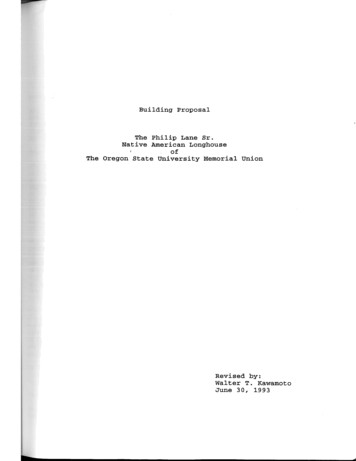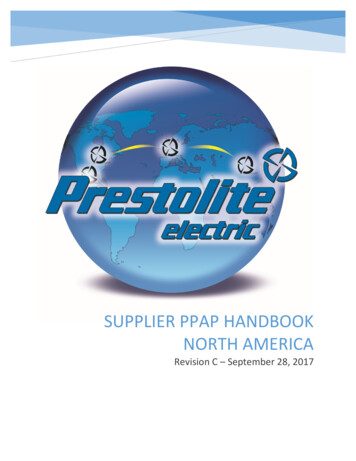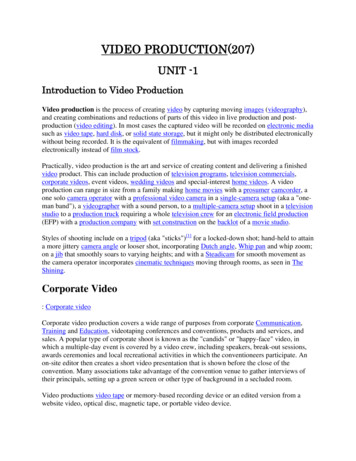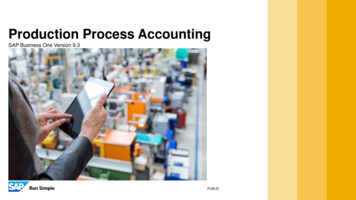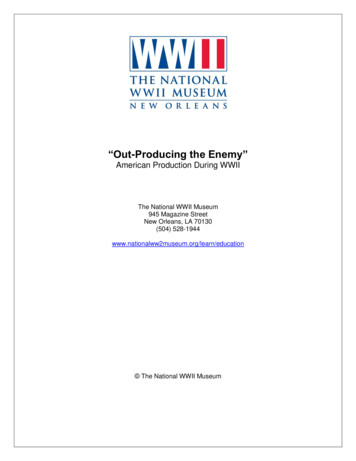
Transcription
“Out-Producing the Enemy”American Production During WWIIThe National WWII Museum945 Magazine StreetNew Orleans, LA 70130(504) 528-1944www.nationalww2museum.org/learn/education The National WWII Museum
“Out-Producing the Enemy:”American Production During WWIIBefore the Japanese bombed Pearl Harbor and the United States entered WWII in December 1941, the Americaneconomy was still weak from The Great Depression. In 1939, the US unemployment rate was high at 17.2% andthAmerica’s military was small, ranking 18 largest in the world after the nation of Romania.A year before America’s entry into the war in 1940, Adolf Hitler, the Nazi leader of Germany, predicted that American warsupplies would not be enough to help the Allies win the war. Hitler said that “an American intervention by mass deliveriesof planes and war materials will not change the outcome of the war.” However, US president Franklin Delano Rooseveltwas determined to prove Hitler and the Axis Powers wrong. Roosevelt told the American people that they must all worktogether to win the war because “powerful enemies must be out-fought and out-produced.”In this lesson, discover how the United States was able to out-produce all other countries during World War II and createa “production miracle.” Students will analyze and graph historical statistics, and use primary sources like photographs,quotes, and propaganda posters to explain how US production helped the Allies to win the war.OBJECTIVES:Students will be able to: Identify and analyze primary and secondary sources including quotes, photographs, andpropaganda posters to learn about the American Home Front experience during WWII. Define the term “production miracle” and explain why this term is used to describe Americaneconomic production during WWII. Discuss the historical factors that contributed to the US wartime “production miracle.” Use WWII production statistics to calculate and graph the rate of US production from 19411945 and compare/contrast this with aircraft production by Great Britain, Germany, andJapan during the same time period.GRADE LEVEL:6-8STANDARDS:Common Core ELA Standards for Writing & Literacy in History/SocialStudies (6-8)CCSS.ELA-Literacy.W.7.9: Draw evidence from literary or informational texts to support analysis,reflection, and research.CCSS.ELA-Literacy.RH.6-8.1: Cite specific textual evidence to support analysis of primary andsecondary sources.CCSS.ELA-Literacy.RH.6-8.7: Integrate visual information (e.g., in charts, graphs, photographs,videos, or maps) with other information in print and digital texts.Common Core Mathematics Standards for Content, Ratios & Proportional Relationships(6-8)CCSS.MATH.CONTENT.7.RP.A.2A: Recognize and represent proportional relationships betweenquantities.National Center for History in the SchoolsHistorical Thinking Standard 2: the student comprehends a variety of historical sources by usingvisual and mathematical data and literary sources.Historical Thinking Standard 3: the student engages in historical analysis and interpretation.TIME REQUIREMENT: 90 minutes; or 2 class periodsMATERIALS:Out-Producing the Enemy: Student Primary Source Analysis worksheetOut-Producing the Enemy: How Much Did the US Produce During the War? Math worksheet“Out-Producing the Enemy”2 The National WWII Museum
KEY TERMS: Allied Powers: the countries that were fighting against the Axis Powers during WWII. Included the UnitedStates, Great Britain, and Soviet Russia after the Germans invaded Russia in June 1941.Assembly line: an arrangement of workers, machines, and equipment in which the product being madepasses from work station to work station until completed. Also called a production line.Axis Powers: the countries that were fighting against the Allied Powers during WWII. Included NaziGermany, Italy, and Japan.Civilians: the men, women and children of a country who are not fighting in the military during a war.Great Depression: a long period of worldwide economic collapse after the US Stock Market Crash in 1929 inwhich many people were out of work and many banks and businesses failed. This period lasted in the USuntil the country entered WWII and began producing goods for the war effort.Home Front: the name given to the homeland or civilian area of a country that is at war and whose military isfighting away from home.Primary source: an original or first-hand document, story, or object that was created by someone during thetime period under study.Production miracle: the term given to America’s enormous rate of economic production during WWII.Rationing: the government’s program to provide enough food and materials to fight the war by equallydividing up limited resources of food, gas, and other materials among all Americans using a coupon and pointsystem.Secondary source: an account, object, or interpretation of an event which was created by someone withoutfirst-hand experience of the time period under study.Total war: an unrestricted type of war in which both the military and civilians at home are expected tocontribute to the war effort and run the risk of being attacked by the enemy.DIRECTIONS:Part One:1. Brainstorm/problem-solving activity: As the students enter the room, explain that they will be learning aboutUS participation and production in WWII today. To begin, divide them into pairs and ask them to imagine that theyare meeting with US President Franklin Roosevelt and his advisors in the early 1940s to discuss US preparationsfor war. To prepare for this meeting, student groups will need to answer the question, “What types of things doyou need to win a war?” They have three minutes to think about, list and discuss all of the things (people,materials) that are needed to win a war and to write these in their notebooks. (3 min.)2. Reconvene as a class to review and discuss group responses and list answers on the board. Ask students toexplain how/why their answer is needed to win a war. Examples can include men to fight in the military, guns tobe used in battles, metal to make weapons, women to work in the factories while the men are off fighting,factories to produce weapons and other materials, etc. (7 min.)3. Explain that before the US entered WWII in 1941, it was not clear that the country would be able to produceenough of the goods necessary to fight the war in the large quantities that were needed. America was still in thethGreat Depression, with high unemployment and in 1939, the US military was also 18 largest in the world after thecountry of Romania. The US had approximately 630,000 soldiers compared with Germany and Japan, who hadover 4 million soldiers each. Share the Hitler quote and ask, “What does this tell you about what the enemies ofthe US thought about America’s production power and importance in the war? (10 min.) “ An American intervention by mass deliveries of planes and war materials will not change the outcomeof the war.” ---Adolf Hitler, leader of Nazi Germany, 1940.Follow up this quote by sharing the Roosevelt quote: “Powerful enemies must be out-fought and out-produced--Franklin Delano Roosevelt, President of theUnited States, 1941-2Tell students that they are going to figure out how the United States was able to out-produce its enemies byexploring historical clues made during WWII or primary sources. Review the terms primary and secondarysources. After this primary source investigation, they will use math to figure out how much more the US was ableto produce than its enemies or Allies during the war.“Out-Producing the Enemy”3 The National WWII Museum
4. Hand out the primary source sheet. Explain that students will have 25-30 minutes to study each source closelyand explain what important information that it tells them about US production during WWII by completing theprimary source analysis chart. (25 min.)Note: It is up to the teacher to decide if they want students to complete the source analysis activity as a group orindividually. Alternatively, sources can be divided up and assigned to different students or groups to shorten thelength of time needed for this activity.5. Reconvene the class after the primary source analysis activity and take volunteers to describe each source andexplain what the source tells them about life on the American home front. Ask the students at the end of eachreport out: “What information does this source tell me about US production during WWII?” Theirclassmates can also take notes in their notebooks or on their worksheets as the teacher records responses on theboard. (10 min.)Part Two:6. Next, explain to the class that they will be doing a math activity using production statistics from WWII to learnwhat types of things that the US produced for the war effort and how much of each item they made between1941 and 1945. Introduce the term, “production miracle” and tell the students that this is a name that is oftengiven to America’s enormous amount of production during the war. Ask the students to think about and sharedefinitions of what that term might mean and tell them that the class will revisit this term after they complete themath and line graph activity sheet.7. Handout worksheet, colored pencils, and calculators. Note: The recommended time amount for this activity is 2530 min. If there is not enough time in class for students to begin or complete the worksheet, the math activity canalso be assigned for home work.8. Conclude the class by asking them to reflect on and share their answers to these two questions: How did the USperform a production miracle? In your opinion, what were some of the most important factors thatcontributed to the high rate of US production? (10-15 min.)Take Home Art Reflection Activity:Now that the students have had an opportunity to learn more about American production and life on the Home Frontduring WWII, they must create a motivational WWII propaganda or recruitment poster based on what they havelearned today. Each poster must have a strong message and image that recruits or otherwise encourages Americansto increase wartime production to win the war. They can look for inspiration and learn more about WWII propagandatechniques by visiting the classroom resources area of The National WWII Museum’s “We Can We Will We Must!Allied Propaganda Posters of WWII” website.ASSESSMENT:Components for assessment include the Out-Producing the Enemy: Student Primary SourceAnalysis worksheet, the Out-Producing the Enemy: How Much Did the US Produce During theWar? Math worksheet,classroom discussion, and take home art reflection activity.ENRICHMENT:Teachers can deepen student knowledge of US Home Front production by pairing this lessonwith the “Who’s Who in WWII Production” fact sheet and industrialist Facebook profile activity andthe “Manufacturing Victory Matching Activity: Who Produced What for the War?, Additionalprimary sources like oral histories with factory workers and government propaganda films can befound on the “Manufacturing Victory” exhibition website. Local teachers can also bring theirstudents onsite for a field trip to The National WWII Museum to see the “Manufacturing Victory:Arsenal of Democracy” exhibit while it is on display and the Home Front galleries. The “Out-Producing the Enemy” lesson can also be used in conjunction with the study of thechanging roles and expectations of, as well as discrimination faced by women, African Americansand others during WWII, or to enhance a pre-existing WWII unit. To find additional informationabout these topics, visit The National WWII Museum’s Focus On and Fact Sheets pages.Students can also explore and listen to oral histories of women and African Americans on TheDigital Collections of The National WWII Museum’s website, ww2online.org.“Out-Producing the Enemy”4 The National WWII Museum
RESOURCES: What was life like for students on the Home Front during WWII? How did they contribute to thewar? Students can explore this topic by investigating the Museum’s “See You Next Year:” HighSchool Yearbooks From WWII” website at ww2yearbooks.org and “The Classroom VictoryGarden Project” website. Have students compare and contrast their current life as a student withstudents from the WWII era and develop a creative reflection piece (story, poem, drawing, orclass mural) that shows how life for people their age has changed over time, and also showswhat things have stayed the same. Oral History Project: Students can locate and interview family members or other local residents intheir community to discover what life was like for civilians on the Home Front when American wasat war. Students can begin with members of the WWII generation but can also interview peoplewho lived through the Vietnam War and more recent wars in Iraq and Afghanistan. Museumguidelines for conducting oral histories and watching interviews on The Digital Collections of TheNational WWII Museum are a good place for students to start their research. As a longer-term research project, have students research their local area’s contributions to theWWII war effort and create a mini-exhibit. Student research can include collecting images,stories, and other primary sources connected with rationing and scrap drives, Victory Gardens,local factory production, and other aspects of life on the Home Front. Then, students can submitan image and write a brief label for their picture for inclusion in a classroom exhibit about life intheir town during WWII. Alternately, the teacher can set up an account on HistoryPin.com,Pinterest or another social media platform to share the town’s WWII story and continue to collectinformation from community members.The National WWII Museum “The Classroom Victory Garden Project” website The Digital Collections of The National World War II Museum Explore WWII History feature Focus On: “African Americans” and “Women at War” features Fact sheets Lesson Plans: The Home Front and STEM categories Museum Blog features: “Home Front Friday” and “Worker Wednesday” Research Starters for Students: Higgins Boats, Home Front, Rationing, Women in WWII “Science and Technology During WWII” website “See You Next Year!: High School Yearbooks from WWII” website “We Can We Will We Must! Allied Propaganda Posters of WWII” special exhibit websiteNational Archives and Records Administration www.archives.gov DocsTeach.org, Documents from The Great Depression and World War II Eras World War II Photograph Collections“Out-Producing the Enemy”5 The National WWII Museum
Out-Producing the Enemy:How Much Did the US Produce During the War?Student WorksheetPart One: WWII Aircraft Production by CountryDirections: The US produced an incredible amount of weapons during the war. How much was it producingcompared to other countries like its ally Great Britain, and its enemies, Germany and Japan? To find out, usethe aircraft production table below, and plot the production levels of each country to complete the line graph.Great Britain has already been graphed for you. When you are finished graphing, answer the followingquestions about the graph.A. Amount of WWII Aircraft Production By Country, 1941-1945 (all types)194119,43320,09412,4015,088United StatesGreat 42194319441945YEARSUnited StatesGermanyGreat BritainJapan“Out-Producing the Enemy”6 The National WWII Museum
Out-Producing the Enemy:How Much Did the US Produce During the War?Student WorksheetB: Use your completed line graph to answer the following questions:1. What year did US aircraft production surpass: Great Britain? Germany? Japan?2. Using your prior knowledge of WWII history, give 2-3 reasons why you think US aircraft productionrapidly increased while the other three countries started to slow down during the war.Part Two: Total US Military Production in WWII (1941-1945)Directions: From its entry into the war in 1941 until 1945 when WWII ended, the United States was able to outproduce both its allies and its Axis enemies. How much did the US actually produce during the war? Below is atable of the total amount of war supplies that the United States produced during the 45 months that it was atwar during WWII (1941-1945). Calculate approximately how much of each item was produced by the US eachmonth during this 45 month time period to complete the table below.Total US Wartime Military Production Table:Military Item:Total Number ProducedDuring War:Approximate Number MadePer Month(Total Number Produced 45months at war)Aircraft carrier ships1072 per monthTanks352Airplanes300,000Machine Guns2.6 millionBullets41 billion“Out-Producing the Enemy”7 The National WWII Museum
“Out-Producing the Enemy:” AmericanProduction During WWIIStudent Source Analysis WorksheetDirections: Below are historical sources that provide you with clues about why the US was able to produce massive amounts of war supplies during WWII. Studyeach source carefully. Using your prior knowledge of US history and powers of observation, explain why your source is important and what it tells you aboutAmerican production on the Home Front during WWII.Primary Source:Who was thissource made foror used by? Howcan you tell?Describe the source:What information does this source tell me aboutUS production during WWII?Source A:Caption: “United We Win” poster. WarManpower Commission, Washington, D.C.,1943. The Collection of The National WWIIMuseum, 2013.077.113.“Out-Producing the Enemy”8 The National WWII Museum
Primary Source:Who was thissource made foror used by? Howcan you tell?Describe the source:What information does this source tell me aboutUS production during WWII?Source B:Caption: Dorothy Capielano, Higgins AircraftPlant Identification Badge, 1943. Gift of GeraldLanoix, from the Collection of The NationalWWII Museum, 1999.051.“Out-Producing the Enemy”9 The National WWII Museum
Primary Source:Who was thissource made foror used by? Howcan you tell?Describe the source:What information does this source tell me aboutUS production during WWII?Source C:“[Working at the shipyard in Mobile,Alabama] was seven days a week. Andduring the war when [production] was sostrong, it was twelve-hour days, five days aweek, ten hours on Saturday, [and with only]eight hours on Sunday, you felt like you hada week off.”--Clyde Odom, foreman at Alabama Dry DockShip and Building Company. Quote from TheWar website, www.pbs.org/thewar, September2007.Source D:Caption: Chrysler Corporation’s Detroit ArsenalTank Plant, 1940s. Courtesy of the NationalAutomotive History Collection, Detroit PublicLibrary.“Out-Producing the Enemy”10 The National WWII Museum
Primary Source:Who was thissource made foror used by? Howcan you tell?Describe the source:What information does this source tell me aboutUS production during WWII?Source E:Caption: “Rationing Means a Fair Share for Allof Us,” poster. US Office of Price Administration,Washington, D.C., 1943. Courtesy of theNational Archives and Records Administration.“Out-Producing the Enemy”11 The National WWII Museum
Primary Source:Who was thissource made foror used by? Howcan you tell?Describe the source:What information does this source tell me aboutUS production during WWII?Source F:Caption: Page from Bolton High School’s TheBruin yearbook showing the Scrap Paper andGrease student clubs. Alexandria, LA: 1944.From the Collection of The National WWIIMuseum. See the entire yearbook online atww2yearbooks.org.THINK: Based on what you have learned, why do you think that people call the rate of U.S. WWII production a “production miracle?”“Out-Producing the Enemy”12 The National WWII Museum
Manufacturing Victory Matching Activity:Who Produced What for the War?Directions: During WWII, many well-known companies had to stop producing their regular consumergoods like cars or toys, to start producing war supplies for the US military. Match the companies belowwith one of the items that they made for the war effort.1. Ford Motor CompanyBefore War: Made carsA. Handie- Talkie Radio2. Mars Candy CompanyB. War Ship3. Brown and Root ConstructionCompanyBefore War: Made roads and damsC. B-24 Bombers4. Motorola (Galvin ManufacturingCorporation)D. M&Ms for soldiers that doesn’tmelt in their hands5. Chrysler CorporationBefore War: Made carsE. TanksThe National WWII Museum 945 Magazine Street, New Orleans, LA 70130nationalww2museum.org
Manufacturing Victory Matching Activity:ANSWER KEY:1. C. In 1941, Ford Motor Company made plans to build a mile-long, quarter-mile long plant inMichigan named Willow Run. This plant produced over 8,000 B-24 Liberator planes, nearly halfof the more than 18,000 B-24s produced during WWII.2. D. Mars Candy Company made and patented M & M candies for soldiers in 1941. M & M’s weredesigned with a hard shell coating to prevent the chocolate from melting in extreme conditionslike the Pacific, and were only sold to the US military during WWII.3. B. Brown and Root Construction Company in Texas promised to build whatever was needed forthe U.S. war effort. Before the war, Brown and Root had only built roads and dams. However,during the war, they began producing much-needed destroyer escort boats, even though theyhad never build any boats before the start of the war.4. A. The Galvin Manufacturing Corporation, later Motorola, received contracts from the USgovernment to make a light-weight, battery powered, two-way AM radio that could be used bysoldiers in battle. This product was called the “Handie-Talkie” and Motorola went on to makethings like the handheld cell phones we use today.5. E. Since no cars were being produced for civilians during the war, car companies like Chryslerconverted their factories to make other war items like tanks.The National WWII Museum 945 Magazine Street, New Orleans, LA 70130nationalww2museum.org
Manufacturing Victory: Who’s Who in WWII ProductionIn order for America to wage a total war during WWII, it took an army of individuals on the Home Front toswitch over factories from producing consumer goods to making war equipment for the US military. Beloware a few of the men in American Industry who helped the country to achieve this goal.William Knudsen, CEO of General Motors:William Knudsen (1879-1948) came to the US as a poor immigrant from Denmark. He worked hisway up the economic ladder by starting as a dockworker, and eventually became an assistant toHenry Ford, the automobile manufacturer. During his work at Ford, Chevrolet, and then as CEOof General Motors (GM) from 1937-1940, Knudsen revolutionized mass production by buildingmore flexible and efficient production plants. In 1940, President Roosevelt selected Knudsen tolead the nation’s National Defense Advisory Council to prepare for war, and he became the first“Dollar-a Year-Man” by leaving his 300,000 a year job at GM to volunteer to direct thegovernment industrial production effort. Knudsen made the Arsenal of Democracy possible as USDirector of Production by simplifying government contracting and repayment procedures,making it easier for corporations to produce for the war effort.Albert Kahn, Industrial Architect:Albert Kahn (1869-1942) immigrated to the US from Germany and became one of the mostfamous industrial architects in the world. While building factories in Detroit, MI for the Packardand Ford Motor Companies, he pioneered the use of reinforced concrete in construction. He alsobelieved in creating a healthier environment for workers by incorporating large windows into hisdesigns for light and air flow. He was best known for designing Ford’s Highland Park plant, whichmastered assembly line production; the Detroit Arsenal Tank Plant (DATP) which was the firstplant ever built to mass produce tanks; and Ford’s massive Willow Run Bomber Plant to make B24 bombers. Willow Run was the largest factory ever built at the time, with an assembly line thatwas over a mile long under one roof.Fred Geier, President of Cincinnati Milling Machine Company and Machine Tool Builders Association:Fred Geier (1983-1981) was the son of German immigrants. Born in America, Geier was a welleducated and quiet man who was at the forefront of America’s preparation for war. During hispre-war travels to Germany in the 1930s as president of the Cincinnati Milling MachineCompany, Geier witnessed Germany’s industrial mobilization for war. In 1938, he began expandhis company’s production capacity and Geier was one of the first industrialists that Knudsenrecruited to increase America’s wartime production. In 1941 alone, Geier’s work helped to nearlydouble US machine tool production overall, and his company produced a new machine toolevery 17 minutes during the war.Edsel Ford, President of Ford Motor Company:Edsel Ford (1893-1943) was the son of famous automobile producer Henry Ford. As President ofFord Motor Company from 1919-1943, he often clashed with his father about mobilizing thecompany to prepare for war against Germany, since Henry was a strict isolationist. After Henryvetoed the construction of Merlin-Packard engines for the government in 1940, Edsel created hisown plan to support the war effort. In 1941, he asked Albert Kahn to design and build the WillowRun plant to build B-24 Liberator Bombers, converting Ford Motor Company from car to airplaneproduction. Although Edsel died of stomach cancer before its completion, the Willow Run plantbecame the largest plant in the country, breaking production records by eventually producing350 Liberators a month, and building almost half of the 18,000 B-24s made during the entirewar.The National WWII Museum 945 Magazine Street, New Orleans, LA 70130nationalww2museum.org
R.G. Le Tourneau, Inventor and Founder of Le Tourneau Technologies:R. G. Le Tourneau (1888-1969) was born in Vermont in 1888 and left school at an early age. Aninventing genius, Le Tourneau founded his own company, Le Tourneau Technologies in 1929, andthe company soon became the largest manufacturer of heavy earthmoving equipment andsupplies in the world. During his lifetime, Le Tourneau secured nearly 300 engineering patents forhis inventions, receiving 78 patents in WWII alone. He is credited with introducing heavy dutyrubber tires to the earthmoving industry, as well as designing bulldozers, portable cranes, bridgespans and offshore oil drilling platforms. Le Tourneau and his company supplied 70% of all theheavy earthmoving equipment used by the Allies during WWII.Henry Kaiser, Builder and Philanthropist:Before WWII, Henry Kaiser (1882-1967) was known for constructing the Hoover Dam. During thewar, Kaiser became famous for building Liberty Ships, which were needed to ship war supplies andtroops around the world. Although he and his company had never produced ships before the war,Kaiser was determined to produce as many ships as the country needed by building vast shipyardsin San Francisco which ran year-round, 24 hrs a day, with three eight-hour work shifts each day.Kaiser also sped up production by introducing creative, time-saving subassembly techniques, likewelding sheets of metal together instead of riveting. In this way, Kaiser’s factories were able tobreak production records, achieving the amazing feat of building and launching the Liberty Ship SSRobert E. Peary in just 4 days and 15 hours. A noted philanthropist, Kaiser also set up KaiserPermanente first aid centers to provide health care for workers and was the National Chair for theUnited Clothing Collection for International War Relief.Andrew Higgins, Businessman and Shipbuilder:Andrew Jackson Higgins (1886-1952) was the founder of Higgins Industries, a small shipbuildingcompany based in New Orleans. Before WWII, Higgins designed and produced a variety ofamphibious crafts for oil and gas exploration in Louisiana. Since amphibious boats were capableof delivering both people and equipment from the water to land without the use of a harbor,Higgins was awarded large government contracts to produce his “Higgins Boats” for use in everytheater of fighting during the war. His craft included amphibious LCTs (Landing Craft Tanks),LCPLs (Landing Craft Personnel Large), and the famous LCVP (Landing Craft Vehicle Personnel)which was used during the D-Day landings at Normandy to land troops, tanks, jeeps, trucks, andother types of equipment on to the beaches. Higgins Industries produced more than 20,000 typesof Higgins Boats, along with PT and other supply boats during the war during the war. Thecompany was also notable for being the first plant in New Orleans to fully integrate, paying menand women, regardless of race, age or disability, equal wages for the same type of work. Thewartime legacy of Andrew Higgins and Higgins Industries, and the work of historian StephenAmbrose is the reason why The National WWII Museum is located in New Orleans today.Extension Activity: Assign each student one of the U.S. industrial men profiled on the fact sheet. Have the studentsconduct additional research on their individual and develop a Facebook profile page for this person. Their profilesshould include the name and picture of the person, their birthday, their current job and work skills, interests (sports,books, quotes) and friends from the WWII era whom they knew and worked with, including some of the other men onthe fact sheet.The National WWII Museum 945 Magazine Street, New Orleans, LA 70130nationalww2museum.org
Total war: an unrestricted type of war in which both the military and civilians at home are expected to . Take Home Art Reflection Activity: Now that the students have had an opportunity to learn more about American production and life on the Home Front during WWII, they must create a motivational WWII propaganda or recruitment poster based .







